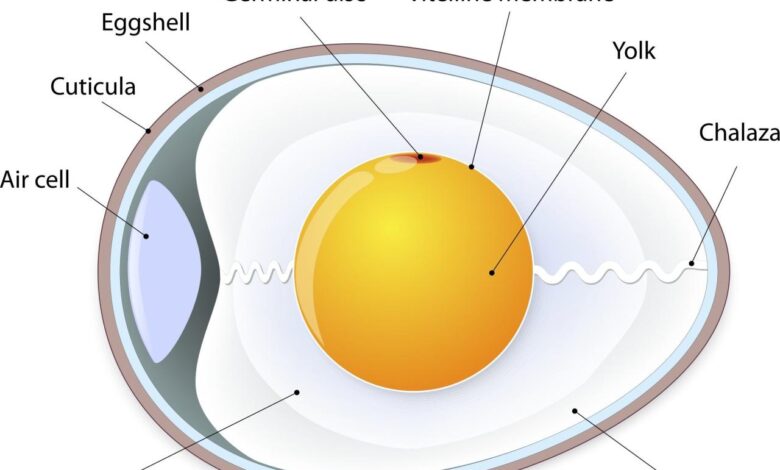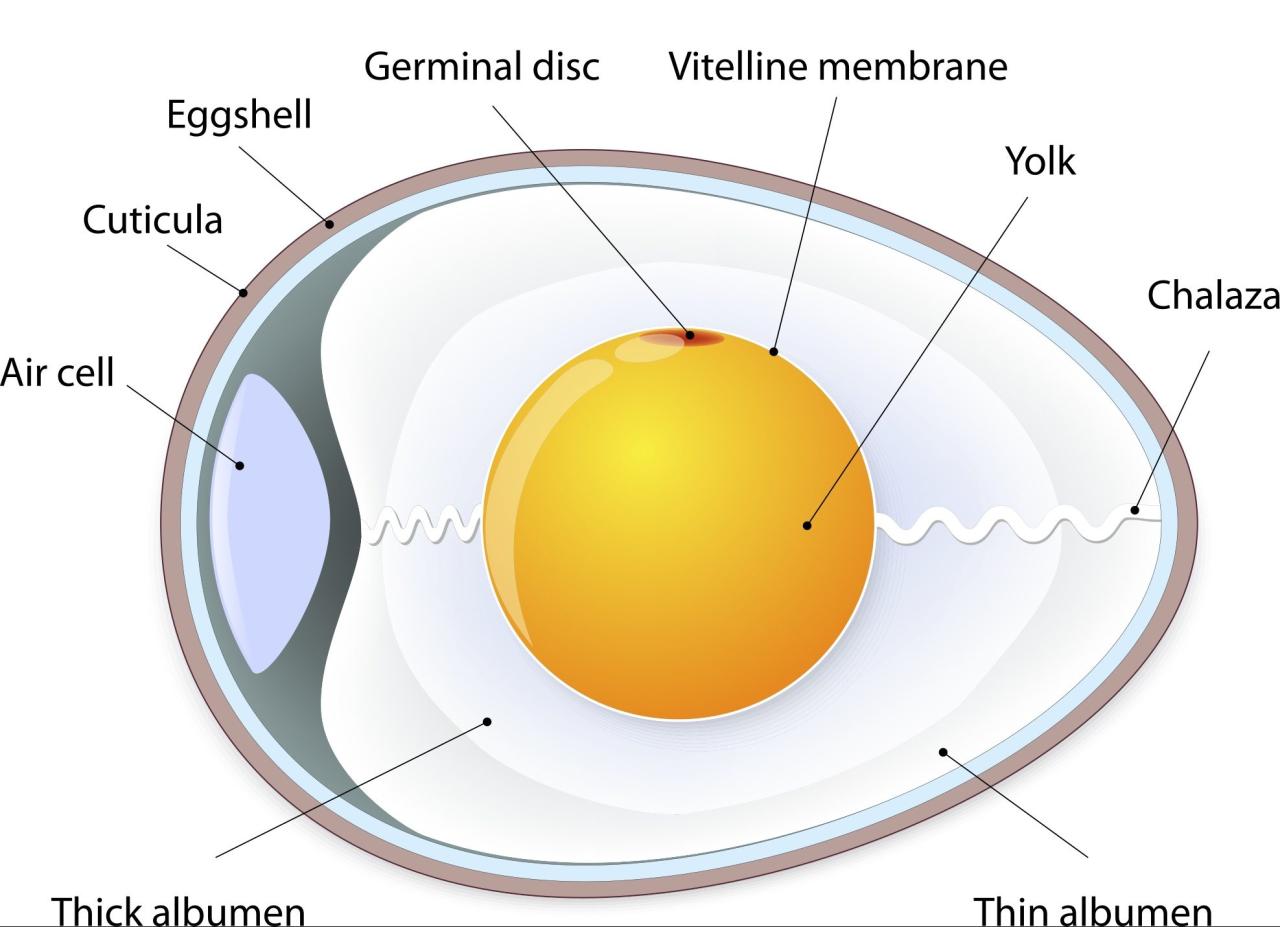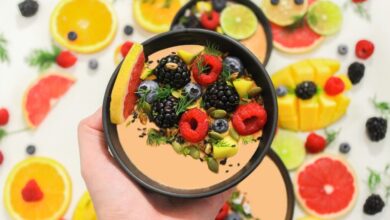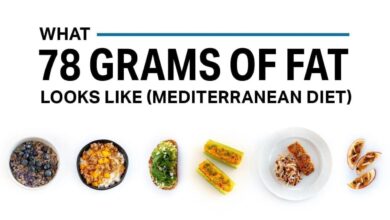
Unscrambling the Science Behind Eggs: A Deep Dive
Unscrambling the science behind eggs, we embark on a fascinating journey into the world of these humble yet remarkable culinary staples. From the intricate structure of their anatomy to the complex biochemical processes that govern their formation, eggs hold secrets that have captivated scientists and cooks alike for centuries.
This exploration delves into the heart of the egg, revealing the secrets of its composition, the nutritional powerhouse it represents, and the incredible transformations it undergoes during cooking. We’ll unravel the science behind egg preservation, explore its diverse uses, and even consider the environmental impact of egg production.
Get ready to crack open a world of knowledge about these everyday wonders!
The Chemistry of Egg Formation and Development: Unscrambling The Science Behind Eggs

The formation of an egg is a complex and fascinating process, involving a intricate interplay of biochemical reactions and physiological mechanisms. This process begins with the development of the yolk, a rich source of nutrients that will nourish the developing embryo.
The yolk is then surrounded by the albumen, or egg white, which provides water and proteins. Finally, the egg is encased in a hard shell, providing protection and a barrier against external factors.
The Synthesis of Essential Components
The synthesis of proteins, lipids, and other essential components is crucial for the formation of a viable egg. The yolk, the primary nutrient source for the developing embryo, is rich in proteins, lipids, and vitamins. The synthesis of these components is regulated by hormones and enzymes, which ensure the efficient utilization of nutrients by the developing oocyte.
- Protein synthesis:The yolk is rich in proteins, which are essential for the growth and development of the embryo. The synthesis of these proteins is regulated by the liver, which produces vitellogenin, a precursor protein that is transported to the ovary and incorporated into the yolk.
- Lipid synthesis:Lipids are another essential component of the yolk, providing energy and building blocks for cell membranes. The synthesis of lipids in the yolk is regulated by enzymes, which catalyze the conversion of fatty acids into triglycerides and phospholipids.
- Other essential components:The yolk also contains vitamins, minerals, and other essential components that are crucial for the development of the embryo.
These components are synthesized in various tissues and organs, and they are transported to the ovary and incorporated into the yolk.
Calcium in Shell Formation
The hard shell of an egg is primarily composed of calcium carbonate, which is deposited by the oviduct. The process of calcification, the formation of the shell, is a complex and highly regulated process that requires a significant amount of calcium.
- Calcium absorption:The hen absorbs calcium from her diet, primarily from feed and grit. This absorbed calcium is transported to the bloodstream and then to the oviduct.
- Shell gland:The shell gland, or uterus, is the site of shell formation. In this gland, calcium is extracted from the bloodstream and deposited onto the egg as calcium carbonate.
Learning about the science behind eggs has been a fascinating journey, especially discovering the complex process of how they develop. It’s made me think more about the ingredients I use in my cooking, like the sweet potatoes in my favorite marinated mushroom sweet potato tacos.
Now, I’m curious to explore the science behind how those sweet potatoes grow and the nutrients they contain. It’s amazing how much there is to learn about even the simplest things in our kitchens!
- Calcification process:The calcification process is facilitated by enzymes and proteins, which control the rate of calcium deposition and the structure of the shell.
Factors Influencing Egg Size, Shape, and Color
The size, shape, and color of an egg are influenced by a combination of genetic and environmental factors. The genetic makeup of the hen determines the basic characteristics of the egg, while environmental factors, such as diet and stress, can influence the size, shape, and color of the egg.
- Genetics:The breed of hen plays a significant role in determining the size, shape, and color of the egg. For example, Leghorn hens are known for producing small, white eggs, while Rhode Island Red hens produce larger, brown eggs.
- Diet:The diet of the hen can also influence the size, shape, and color of the egg. A diet rich in calcium will result in a thicker, stronger shell, while a diet deficient in calcium may lead to thin or weak shells.
- Stress:Stress can also affect the size, shape, and color of the egg. Hens that are stressed may produce smaller, thinner-shelled eggs.
The Egg as a Source of Nutrition
The humble egg, a culinary staple across cultures, is more than just a breakfast treat. It is a nutritional powerhouse packed with essential vitamins, minerals, proteins, and healthy fats. Understanding the nutritional profile of eggs can shed light on their significant contributions to a balanced diet and overall health.
Nutritional Profile of Eggs
Eggs are a remarkably complete source of nutrition, offering a wide array of essential nutrients in a readily digestible form. Here’s a breakdown of their key components:
- Protein:Eggs are an excellent source of high-quality protein, containing all nine essential amino acids that our bodies cannot produce on their own. Each large egg provides about 6 grams of protein, contributing to muscle growth, repair, and maintenance.
- Vitamins:Eggs are rich in various vitamins, including vitamin A, vitamin B12, riboflavin, and folate. Vitamin A is crucial for vision, skin health, and immune function. Vitamin B12 is essential for red blood cell production and nerve function. Riboflavin plays a vital role in energy metabolism, while folate is essential for cell growth and DNA synthesis.
- Minerals:Eggs are also a good source of several essential minerals, including selenium, zinc, and iron. Selenium is an antioxidant that protects cells from damage, while zinc is crucial for immune function and wound healing. Iron is essential for red blood cell production and oxygen transport throughout the body.
- Fats:Eggs contain a healthy balance of saturated, monounsaturated, and polyunsaturated fats. While saturated fats have been linked to heart disease, the amount found in eggs is relatively low and does not pose a significant health risk. Monounsaturated and polyunsaturated fats, on the other hand, are beneficial for heart health and cholesterol levels.
Unraveling the science behind eggs is fascinating, from their nutritional benefits to their role in culinary creations. But did you know that the DASH diet, which focuses on lowering blood pressure, can also play a role in understanding how eggs impact our health?
For a comprehensive guide on the DASH diet and its impact on various aspects of health, including heart health, check out everything you need to know about the dash diet. Understanding the DASH diet’s principles can help us better grasp how eggs fit into a balanced and healthy lifestyle.
Nutritional Value of Different Egg Types
The nutritional value of eggs can vary slightly depending on the type of egg, including brown, white, and free-range eggs.
- Brown vs. White Eggs:The color of an egg’s shell is determined by the breed of the hen, not its nutritional content. Both brown and white eggs have essentially the same nutritional profile.
- Free-Range Eggs:Free-range eggs are laid by hens that have access to outdoor areas where they can roam freely. While these eggs may contain slightly higher levels of omega-3 fatty acids and vitamin E, the difference is generally minimal.
Health Benefits of Consuming Eggs
The rich nutritional profile of eggs translates into a wide range of health benefits.
- Muscle Growth and Repair:Eggs are an excellent source of protein, which is essential for muscle growth and repair. This makes them a valuable food for athletes, bodybuilders, and anyone seeking to maintain muscle mass.
- Bone Health:Eggs are a good source of vitamin D, which plays a vital role in calcium absorption and bone health. Adequate vitamin D intake is crucial for preventing osteoporosis, a condition that weakens bones and increases the risk of fractures.
- Cognitive Function:Eggs are rich in choline, a nutrient essential for brain development and function. Choline is involved in the production of acetylcholine, a neurotransmitter that plays a key role in memory, learning, and mood regulation.
Egg Transformations in Cooking
The transformation of an egg from a raw, liquid state to a solid, cooked form is a fascinating process driven by the science of protein denaturation and coagulation. When heat is applied to an egg, the proteins within the yolk and white undergo significant changes, resulting in the familiar textures and flavors we associate with cooked eggs.
The Science of Egg Cooking
The proteins in an egg, primarily albumin in the white and vitellogenin in the yolk, are long chains of amino acids folded into complex three-dimensional structures. These structures are maintained by weak bonds, such as hydrogen bonds and hydrophobic interactions.
When heat is applied, these bonds break, causing the proteins to unfold and unravel, a process called denaturation. As the proteins unfold, they collide and interact with each other, forming new bonds and creating a network of interconnected proteins. This process, known as coagulation, leads to the thickening and solidification of the egg.
Different Cooking Methods, Unscrambling the science behind eggs
The specific cooking method employed significantly influences the final texture and appearance of the cooked egg.
Boiling
Boiling eggs involves immersing them in simmering water for a predetermined period. The heat from the water penetrates the egg, causing the proteins to denature and coagulate. The duration of boiling determines the degree of coagulation, resulting in different textures:
- Soft-boiled eggshave a runny yolk and a slightly firm white.
- Medium-boiled eggshave a creamy yolk and a firmer white.
- Hard-boiled eggshave a solid yolk and a completely firm white.
Frying
Frying eggs involves cooking them in a pan with a small amount of fat. The heat from the pan denatures the proteins, while the fat helps to prevent sticking and adds flavor. The cooking time and temperature determine the final texture:
- Sunny-side up eggsare fried with the yolk facing up, resulting in a runny yolk and a slightly firm white.
- Over-easy eggsare flipped over briefly to cook the yolk slightly, resulting in a soft, slightly runny yolk.
- Over-medium eggsare cooked longer, resulting in a firmer yolk.
- Over-hard eggsare cooked until the yolk is completely solid.
Poaching
Poaching involves cooking eggs in simmering water without the shell. The gentle heat allows for a delicate texture, with the white remaining tender and the yolk remaining runny. Poached eggs are often served on toast or in salads.
Baking
Baking eggs involves cooking them in an oven, typically as part of a larger dish. The slow, even heat of the oven allows for thorough coagulation, resulting in a firm texture. Baking is commonly used for dishes like quiches, soufflés, and custards.
Creating Egg Dishes
The science of egg cooking extends beyond simply achieving different textures. By understanding the properties of eggs and the principles of protein denaturation and coagulation, we can create a wide variety of delicious and visually appealing egg dishes.
Unraveling the science behind eggs is a fascinating journey, revealing how this humble food can be both a source of nutrition and a potential contributor to cholesterol levels. While some may shy away from eggs due to their cholesterol content, recent research has shown that incorporating them into a balanced diet can actually be beneficial.
In fact, the cholesterol lowering diet staple to eat now is a surprisingly versatile food that can be enjoyed in numerous ways. Ultimately, understanding the science behind eggs helps us make informed dietary choices that support our overall health and well-being.
Scrambled Eggs
Scrambled eggs are created by cooking eggs with milk or cream, stirring constantly to prevent overcooking. The milk or cream adds moisture and richness, while the stirring ensures that the proteins coagulate evenly, resulting in a soft, creamy texture.
Omelets
Omelets are made by cooking eggs in a pan, folding them over to enclose a filling. The key to a successful omelet is to cook the eggs over low heat, allowing the proteins to coagulate slowly and evenly. The filling can be added before or after folding, depending on the desired texture and flavor.
Meringues
Meringues are made by whipping egg whites into a stiff foam. The whipping process incorporates air into the egg whites, creating a light and airy texture. The sugar added to the meringue helps to stabilize the foam and prevent it from collapsing.
Eggs in the Wider World
Eggs, beyond their familiar role as a breakfast staple, are incredibly versatile, playing a vital role in various industries. Their unique properties and nutritional value make them a valuable resource in food production, cosmetics, and pharmaceuticals. However, this widespread use comes with environmental implications, requiring careful consideration for sustainable practices.
Egg Production’s Environmental Footprint
The production of eggs has a significant environmental impact, stemming from various factors including animal welfare, resource consumption, and waste management.
- Animal Welfare:The intensive farming practices prevalent in egg production often raise concerns about animal welfare. Confined spaces, limited movement, and potential for disease outbreaks can negatively impact the well-being of hens.
- Resource Consumption:Egg production requires substantial resources, including land, water, and feed. The production of feed for hens, particularly soy, can contribute to deforestation and habitat loss.
- Waste Management:Egg production generates significant waste, including manure and discarded eggshells. Improper management of these wastes can lead to pollution of water sources and soil contamination.
Sustainable Egg Production: Challenges and Opportunities
The pursuit of sustainable egg production faces numerous challenges, but also presents opportunities for positive change.
- Shifting Consumer Demand:Increasing awareness of the environmental impact of food production is driving consumer demand for sustainable egg options. This shift presents a market opportunity for producers who prioritize ethical and sustainable practices.
- Technological Advancements:Innovations in animal housing, feed production, and waste management are contributing to a more sustainable egg industry. For example, cage-free systems and alternative protein sources in feed can reduce environmental impacts.
- Collaboration and Partnerships:Collaboration between producers, retailers, and consumers is crucial for driving sustainable change. Initiatives like certification programs and consumer education campaigns can help promote responsible egg consumption.
Final Thoughts
As we’ve seen, the seemingly simple egg is a marvel of nature, packed with nutritional value and capable of incredible culinary transformations. From the moment it forms within a hen’s body to the countless dishes it graces, the egg’s journey is a testament to the power of science and the ingenuity of human creativity.
So next time you crack open an egg, take a moment to appreciate the intricate world that lies within, a world that’s as fascinating as it is delicious.






